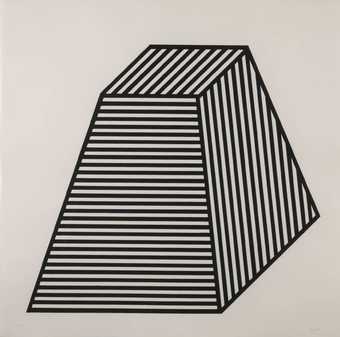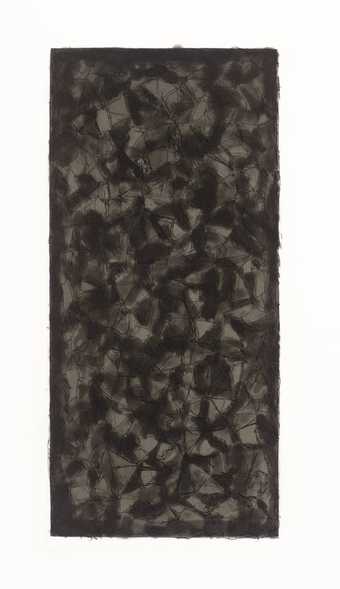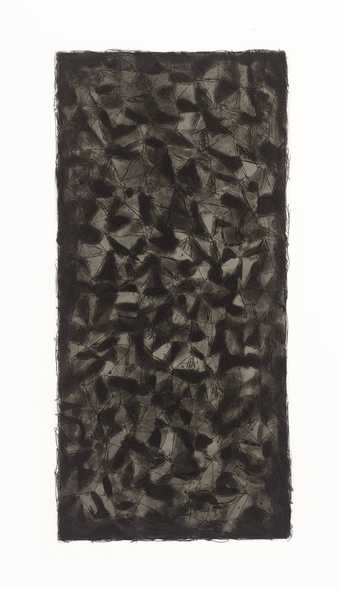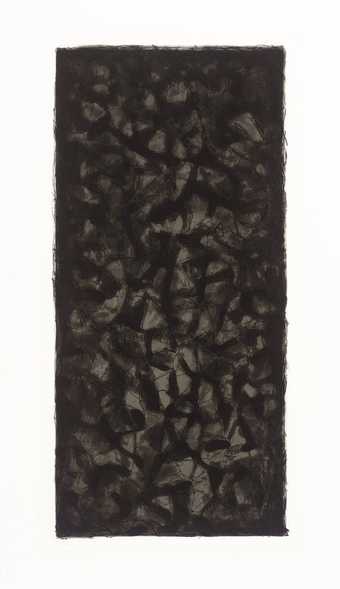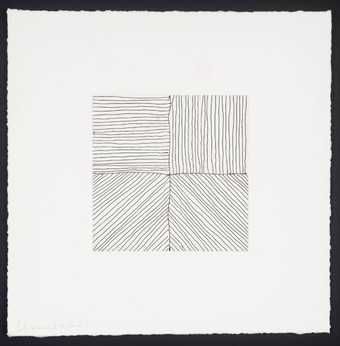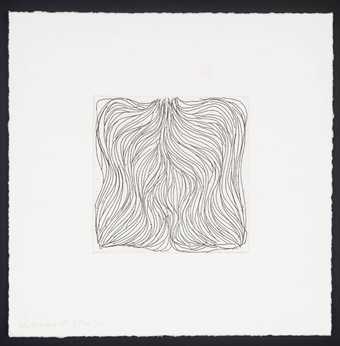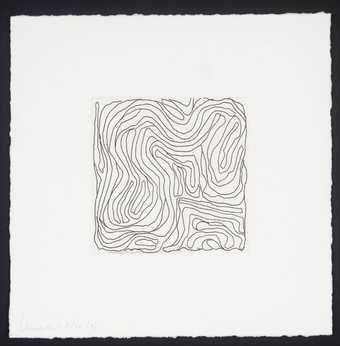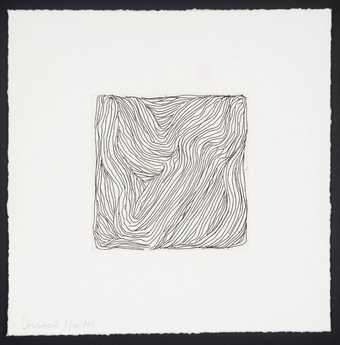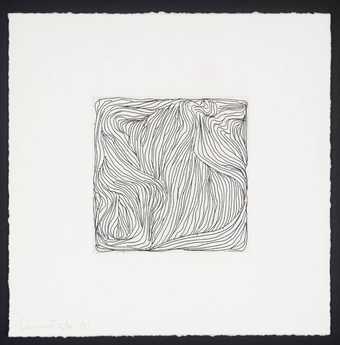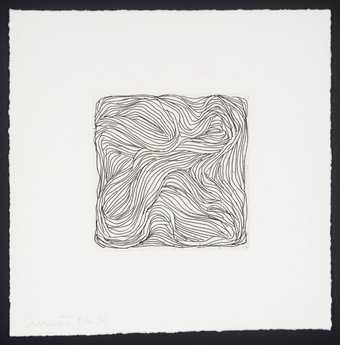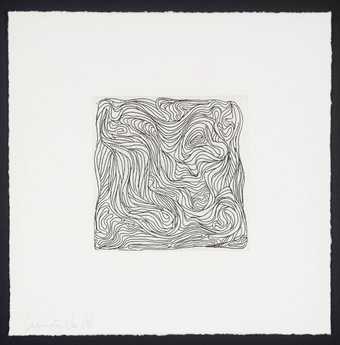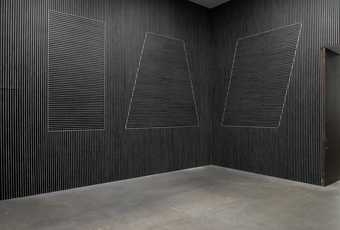In Tate St Ives
- Artist
- Sol LeWitt 1928–2007
- Medium
- Paint on wall
- Dimensions
- Overall display dimensions variable
- Collection
- ARTIST ROOMS Tate and National Galleries of Scotland
- Acquisition
- ARTIST ROOMS Acquired jointly with the National Galleries of Scotland through The d'Offay Donation with assistance from the National Heritage Memorial Fund and the Art Fund 2008
- Reference
- AR00165
Summary
Wall Drawing #1136 is a colourful and lively acrylic paint installation by the American conceptual artist Sol LeWitt, and an example of the artist’s long-term commitment to wall drawing as a central component of his artistic practice. The work is composed of both curved and straight solid bands of colour that are painted directly onto the surface of a wall using every primary (red, yellow, blue) and secondary (green, orange, purple) colour plus grey. The curve, made up of nine interlocking bands in these seven colours (there are two bands each of red and green), snakes along the wall, touching the top and bottom of the wall at various points. The same seven colours reappear, in an irregular sequence, as vertical bands that serve as a background pattern for the curve. Every band in the wall drawing is of the same width and there is no area left empty of colour. With the exception of his very first wall drawing exhibited at the Paula Cooper Gallery in New York in 1968, the artist did not execute the wall drawings himself; rather, he employed draughtsmen or assistants to carry out specific instructions to copy and enlarge his diagram of the drawing to the wall itself.
A letter of instruction, an installation diagram and a certificate pertaining to Wall Drawing #1136 can be found in Tate Gallery Records (PC10.1 LeWitt, Sol). These documents are in a format consistent with all wall drawings issued by the Sol LeWitt Studio prior to the artist’s death in 2007. Wall Drawing #1136 was first installed at the Fraenkel Gallery in San Francisco, California in September 2004 and was drawn by Marta Ayala, Sachiko Cho, Matt DeJong, Amanda Eicher, Melissa Levin, Amy Rathbone, Rick Salas and Paul Wackers. This information, along with a description of the work, is detailed in the wall drawing certificate, which is authenticated and signed by the artist. The accompanying letter, from the Sol LeWitt Studio Manager Susanna Singer, states: ‘Please be advised that the documents are the signature for the Wall Drawing and must accompany the Wall Drawing if it is sold or otherwise transferred. They represent the transfer of ownership from the artist to you … Under no circumstances will we issue a new certificate!’ (Tate Gallery Records PC10.1 LeWitt, Sol.)
The diagram is a small colour inkjet print that lays out the pattern of the wall drawing in one continuous elongated horizontal band, and is accompanied by a statement that reads: ‘This is a diagram for the Sol LeWitt wall drawing number 1136. It should accompany the certificate if the wall drawing is sold or otherwise transferred but is not a certificate or drawing’ (Tate Gallery Records PC10.1 LeWitt, Sol). This emphasises the importance of the finished artwork to the fundamental meaning of the conceptual idea. As the artist clarified in a 1971 article for Art Now: ‘The plan exists as an idea but needs to be put into its optimum form. Ideas of wall drawings alone are contradictions of the idea of wall drawings.’ (Quoted in Zevi 1995, p.96.)
Wall Drawing #1136 can be installed, removed, and then reinstalled in another location, as many times as required for exhibition purposes. As such, there can also be periods of time in which the work does not exist in physical form. The curator John S. Weber explains that: ‘As conceptual ideas that can be drawn, painted over, and redrawn by others, the wall drawings reengineer the fundamental nature of art in ways that favour a new degree of public access … The wall drawing’s very nature is collaborative and participatory ... They are conceived to accommodate their forms to different architectural situations and sites.’ (Quoted in Garrels 2000, p.98.) At the Fraenkel Gallery exhibition in 2004, Wall Drawing #1136 was installed on three walls of eleven feet high, with lengths of seventeen, thirty-six and seventeen feet respectively. When transferred to another location, the number of walls can change only by ensuring that the proportions of the original diagram are retained. In 1970, the artist stated: ‘When large walls are used the viewer would see the drawings in sections sequentially, and not the wall as a whole.’ (Quoted in Zevi 1995, p.91.) The composition of Wall Drawing #1136 is especially suited to the viewer’s gradual, meandering enjoyment of the drawing as it spreads across a number of interconnecting walls.
The artist’s first wall drawings of the 1960s were wholly monochromatic. In 1975 LeWitt introduced coloured grounds to his wall drawings and in 1983 he began to employ colour ink washes. The writer and curator Brenda Richardson has considered a subsequent shift in the nature of the wall drawings, significant to Wall Drawing #1136 and all the works of the 1990s and 2000s:
In the 1990s LeWitt began to favour acrylic as the primary medium for his wall drawings. It was the first new medium … to alter the fundamental aesthetic course of the wall drawings. By adding acrylic to his regular inventory of materials, he began working on walls in what is technically a painting medium. Pencil, crayon, chalk, and ink – the materials used by LeWitt for his wall drawings since 1968 – are traditionally identified as drawing media. LeWitt continued to use the term ‘wall drawings’ for this body of work, regardless of the medium in which the work is executed.
(Quoted in Garrels 2000, p.45.)
This sense of continuity highlights the importance of drawing as a conceptual, rather than strictly material practice for LeWitt. The introduction of acrylic paint into the wall drawings opens up their strict set of rules and procedures to vibrant ranges of colours and bold, graphic shapes – and even more traditional painterly concerns. The artist Ellen Carey has considered this particular facet in a related work, Wall Drawing 1131: Whirls and twirls (Wadsworth) 2004 (Wadsworth Atheneum, Hartford, Connecticut), which shares the same colour scheme as Wall Drawing #1136. She writes: ‘The rainbow’s colours – red, orange, yellow, green, blue, indigo, and violet – are formed when the sun’s rays are reflected and refracted by drops of rain and mist. Forming the basis for LeWitt’s work, this palette acts as a connection between his affinities for nature in general and this phenomenon specifically.’ (Quoted in Cross and Markonish 2009, p.25.) The curve in Wall Drawing #1136 can indeed be read as a series of rainbow arcs joined in progression, blurring the boundaries between abstraction and representation. A comment made by LeWitt in the early 1980s hints at his awareness of the increasingly colourful and exuberant nature of his wall drawings: ‘When represented with the scale that walls have one must begin to engage their physical properties. The theatrical and decorative are unavoidable and should be used to emphasize the work.’ (Quoted in Zevi 1995, p.104.)
Further reading
Adachiara Zevi (ed.), Sol LeWitt: Critical Texts, Rome 1995.
Gary Garrels (ed.), Sol LeWitt: A Retrospective, exhibition catalogue, San Francisco Museum of Modern Art 2000.
Susan Cross and Denise Markonish (eds.), Sol LeWitt: 100 Views, New Haven 2009.
Stephanie Straine
August 2010
Does this text contain inaccurate information or language that you feel we should improve or change? We would like to hear from you.
Online caption
LeWitt was seminal in establishing the notion of ‘Conceptual art’ during the 1960s. This work is one of a number of highly coloured wall pieces he made in the last years of his life. Described simply as ‘curved and straight coloured bands’, it includes seven vibrant colours to create an overwhelming chromatic environment that envelopes the viewer. Nine weaving bands interrupt vertical lines and add a sense of playfulness. Although this dynamism suggests an element of chance, LeWitt’s works are created according to precise instructions that regulate details such as the sequence of colours and width of bands.
Explore
- abstraction(8,615)
-
- non-representational(6,161)
You might like
-
Sol LeWitt Arcs from Four Corners
1986 -
Sol LeWitt [no title]
1982 -
Sol LeWitt [no title]
1991 -
Sol LeWitt [no title]
1991 -
Sol LeWitt [no title]
1991 -
Sol LeWitt [no title]
1991 -
Sol LeWitt Small Etching/Black & White No.1
1999 -
Sol LeWitt Small Etching/Black & White No.2
1999 -
Sol LeWitt Small Etching/Black & White No.3
1999 -
Sol LeWitt Small Etching/Black & White No.4
1999 -
Sol LeWitt Small Etching/Black & White No.5
1999 -
Sol LeWitt Small Etching/Black & White No.6
1999 -
Sol LeWitt Small Etching/Black & White No.7
1999 -
Sol LeWitt Small Etching/Black & White No.8
1999 -
Sol LeWitt Six Geometric Figures ( Two) (Wall Drawings)
1980–1


